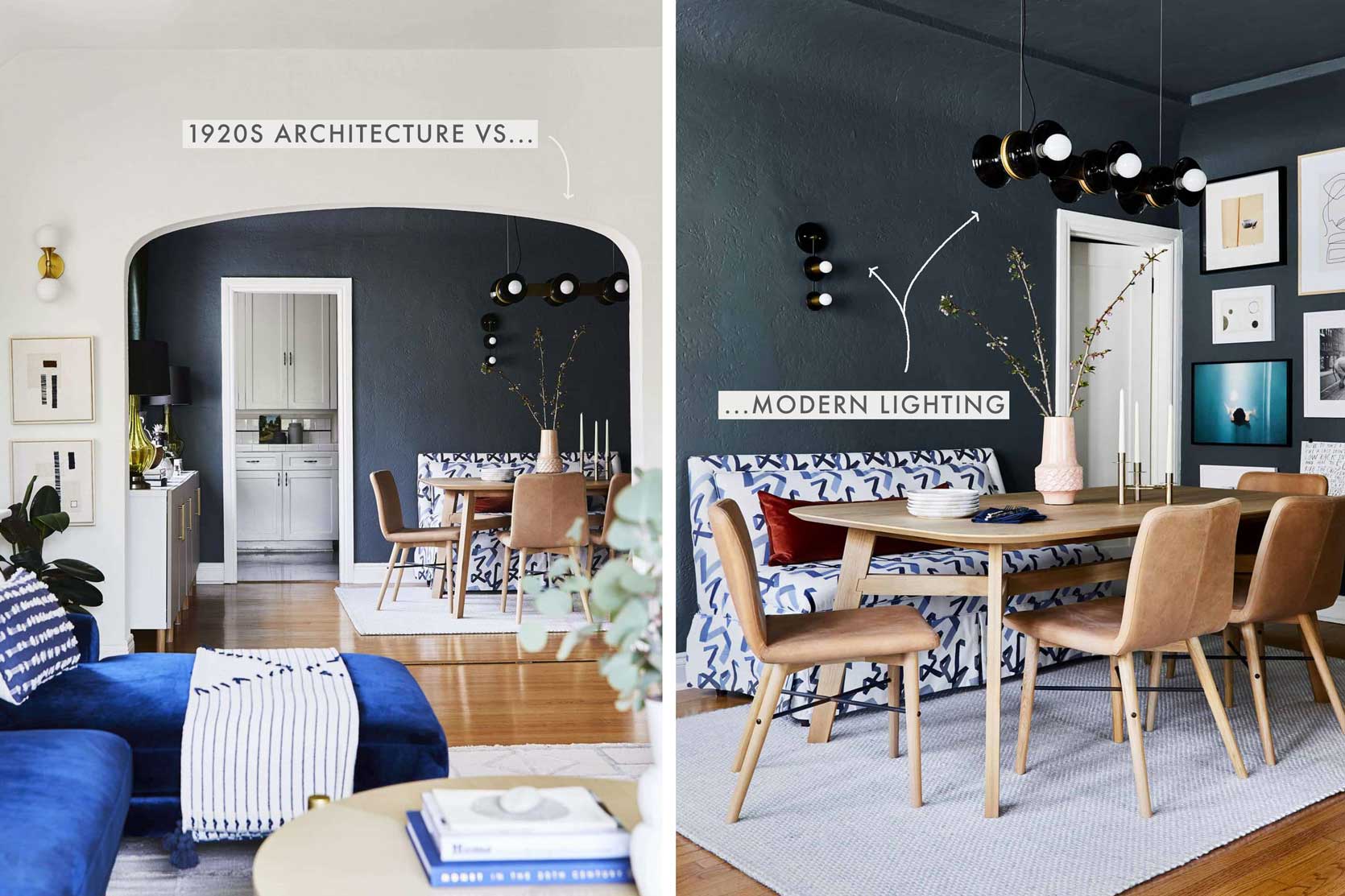Years ago, when I was designing the dining room in my previous home, I kept picking modern furniture and lighting for the space. I liked the juxtaposition of it stylistically against the 1920s Mediterranean architecture of my building. Once I put up my chandelier, sconces, gallery wall, and brought in my wall-to-wall credenza with chunky contemporary brass hardware, I realized it was all too…one note. It was missing something. Sure, I had the contrast between styles but I still craved something else. Something to “funk” it up, or bring a bit more contrast.
It turns out, what I was missing was my vintage brown wood bar cabinet and Rococo-style Venetian gilded mirror. I needed the push and pull of “now” and “old” to satisfy my eye. Make it feel real, lived in, and not like a catalog.
This, my friends, is called tension, and in my opinion, every interesting room needs it in small doses. Now, I say “interesting” because not every space requires tension. There are plenty of beautiful homes and rooms without any noticeable tension; in fact, not having it can really create a sense of placidity, and that’s some people’s preference.
But if your space feels flat, expected and not as elevated as some of the ones you spot in designer profiles or magazines, adding a touch of tension is going to be transformative to you. Tension in design is like picking the pair of ruby-red heels for your all-black outfit. Black heels would have been just fine, even chic, but the red? Well…now you’re standing out.
Before walking through the different ways you can build tension in your design schemes, I just want to explore the word some more, because just saying “add tension!” as advice isn’t exactly clear. Tension brings in a little “conflict.” It’s opposing things that shouldn’t work together but do. Like adding salt to your baked goods to bring out the sweetness. Acid to your rich dishes to cut through the fat. It’s contrast in materials, scale, differing volumes, juxtaposing polar opposite styles, and even colors. It can be as subtle as picking a polished brass chandelier in a room with rough-hewn wood floors and furnishings, or as drastic as putting a modern addition on a centuries-old brick building.
It’s kind of like a decorative surprise, flipping the script on what you *think* you should be doing. Let’s go through some examples of tension in the rooms I’ve designed recently, because visuals always speak louder than words.

Between my old dining room and living room, you can see I went with modern lighting to contrast the 100-year-old architectural style of the spaces. This is one of my favorite tricks for adding tension without having to think too much. That’s not to say that picking lighting fixtures that are appropriate to the era of your home or within its style isn’t good; it totally is! But it certainly adds a bit of a cool factor when they contrast.

In my bedroom, I went with a similar tension treatment of opposing styles: a modern low-slung velvet bed, modern nightstands, sconces, and a modern rug all balanced by a large vintage armoire. To me, this adds so much soul and visual interest. Without it, I think it would have been perfectly lovely, but perhaps a bit expected. I also thought everything was too shiny, so some natural materials like rattan and linen balanced that out. (For anyone getting to this point saying “Isn’t tension just…balance?” I’d tell you, yes…yes it is, but it’s important to understand all the different ways to do it, so let’s keep reading/writing.)


Tension can also come in in terms of shapes: curves vs. angles. I’m fairly certain I didn’t create intentional tension between the curve of my coved ceiling and all the straight angles of my gallery wall, but it certainly applies, so I’m calling it out for you. Something that was on purpose was the punch of cool-toned blue in my otherwise warm kitchen. That’s tension via contrast, and it works every time as long as you are light-handed with it.
What Kinds Of Design Tension Can You Use? Let’s Explore
Alright, let’s dive deeper and see more examples of tension in other peoples’ rooms and designs. This list is not exhaustive, of course, but it’s a great starting point to work from for anyone interested in exploring tension. First up…
Opposing Scales: Big Furniture In A Small Room

A common mistake I see people make in small rooms (or really, any room) is picking furniture that’s simply too small. While there is a limit to the size you can go without totally consuming the space or feeling overly commanding, I do love to see a large, low-slung sofa in a small living space. It’s okay to let it go across half the wall space, I promise. It’s functional and actually can make the room appear larger than it is. You do want to be sure the scale works in at least one way, so even if it’s long/wide, it should still work with the ceiling heights so it doesn’t visually eat the space.
This is another example I love: having just one imposing piece in a room with lower ceilings. That green wood pantry/cabinet thing is enormous, and while I don’t really have a sense of the full layout of the kitchen, I know that that ceiling is likely only about 8 feet (standard counter height is 36 inches, and that space above the green cabinet in the second image is not even three times its height). The cupboard-armoire is kind of hulking, but it works to add interest and a touch of “maybe that shouldn’t be there…wait…maybe it should??”
Scale doesn’t have to just relate to the size of a room compared to furniture; you can use it to play with dimensions of other things, like frames. This eclectic space by Reath Design has tall, voluminous vaulted ceilings, and I love the juxtaposition of that against the gathering of teenie little frames. It’s easy to think “big ceiling, big art” but *this* is how you create character. After all, what’s a story without an antagonist, right? Tension in your design is the conflict point in a plot; without it, it’s just a nice, sweet little tale without any twists or turns or heart-pumping moments. And I don’t know about you, but I love a bit of a nail-biter.
Conflicting Textures: Rough & Organic vs. Luxe
I LOVE creating tension with materials. Let’s take the room of gallerist Almine Rech above, for example. It’s fully enveloped in wood, and anyone wanting to create harmony would have likely picked a sofa covering more in line with something natural, perhaps a Belgian linen. But nope, this room stopped me in my tracks for the sole purpose that it was unexpected. The stress between the earthy paneling and the luscious, luxe, and fringed velvet is a shock to the system, and that is exactly why it’s interesting.
I know that last room wasn’t for everyone (I’m not even saying it was for me, tbh), but tension in material can be a little more subtle. Take for instance the matte terracotta(ish) floor and the organic dining furniture against the glossy fireplace tile. That sheen goes a long way of cutting through all the lusterless materials in this very cute kitchen by Studio Eric Schmitt.
Juxtaposed Styles: Modern Meets Antique
I’ve never run into someone who hates a Parisian apartment. They have tension fully mastered. The ridiculously good architectural details many come with certainly help, and setting anything against it would look good. A dented can of chickpeas from Aldi in the room above would look good, surely. Here, we have lots of very ornate, traditional millwork and plasterwork married with sleek, streamlined mid-century-style furniture. The work of Véronique Cotrel Agency, it’s an interesting match of eras that works beautifully because the seating is fairly minimalist while the walls and ceiling aren’t.
This beautiful space by Fayette Studio illustrates the same thing as the image prior but in a more subtle manner. The ceiling detailing juxtaposes the contemporary furniture beautifully.
This is just so fun (thanks for the visual treat Studio DB!). I’d never expect to see that modern chair and ottoman with the charming wallpaper, molding and sconce chosen here, but it’s a sharp pairing that feels super fresh and interesting. It makes me want to keep looking at it to see if I missed something, even though it’s simple.
There’s almost nothing I love more than a house mullet: business up front, party in the back. Especially when that party is a totally different style than the original structure. The arches, the stucco, and the combo of soft pastels against the serious brick facade is serious tension that pays off if you’re going for “fun” and “quite unexpected.”
Dark Paint In Small Spaces

This way to build tension has been a go-to for so many of us in the design world lately, especially since color drenching became more of a common thing. Sara’s TV room is a great example of this. She took a very compact transitional space (it actually used to be a bedroom) and made it a jewel box by slathering it head to ankle in a moody, dreamy green. A lower ceiling line and a limited square footage might make most people want to make it appear larger but painting it a light or bright color, which you could totally do, but it’s a great opportunity for cognitive conflict!
We see this treatment most often implemented in powder bathrooms. People LOVE drama-filled powder baths, but really they’re just responding to the tension that is created either by an unexpected color choice, a bold wallpaper, an interesting mirror, a luxe lighting pick…you get me.

I say “color” but this can also apply to wallpaper. Sara used the visually chaotic (I mean that in the best way because I love it) Strawberry Thief print from William Morris in her compact walk-in closet. It’s a feast for the eyes in a small space.
Curvy Furniture In An Angular Room
Straight furniture in a boxy room = good. Curvy furniture in a curvy room = good. Curvy furniture in a boxy room = HELL YES. Especially when done just right like in the above room by David Lucido. What makes it even more tenuous is how many straight lines there are between the framing of the wall, the framing of the wall inset, the artwork, the tile flooring, and the grid pattern of the rug. It’s practically screaming for a curvy moment to slice through.
For anyone who isn’t in the custom furniture game (::raises hand::), the curvy-meets-angular tension type can also be satisfied by a piece like the loveseat in the above office. I love it next to the super angled desk, the 90-degree-angle-heavy Greek key rug design, and even the lines running through the paneling on the ceiling.
Contradictory Volume: Low Profile Against High Ceilings
And finally, to satisfy our world of opposites here: when your ceiling goes high, you go low. Of course, this works best when the ceiling looks like THAT, and there’s beautifully ornate molding three-quarters up the wall, but if your budgets are as sky-high as your roofline, consider some low-slung pieces to break from the expected.
***
As we come to the end of my dissertation on building tension, I want to reiterate that not every good room needs such contrast/conflict/juxtaposition. Tension is a useful tool to employ when you want to create intrigue. But it also doesn’t have to be as obvious as a fuschia velvet sofa in a wood-paneled room. I challenge you to look at the spaces in your home that maybe you’re not totally sold on, or don’t feel quite finished, that you wish you could give just a bit more of a designer touch, and see if one of these tension techniques might help you out. A little goes a really long way.
Until next time…
Opening Image Credits: Design & Styling by Emily Henderson | Photo by Sara Ligorria-Tramp | From: My Best Friend’s Basement Remodel – On Finding Their Perfect U-Shaped Comfortable Sectional
THIS POST WAS ORIGINALLY PUBLISHED HERE.


